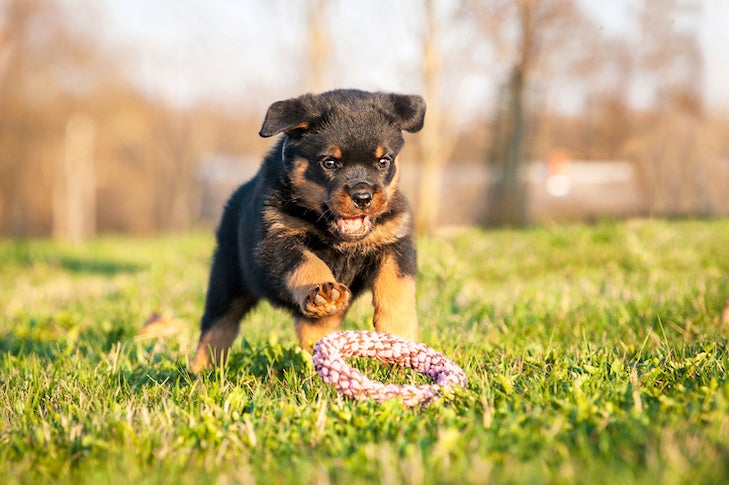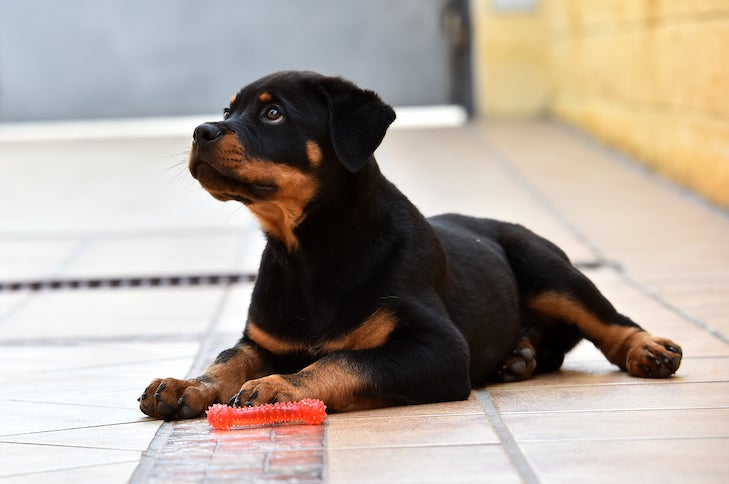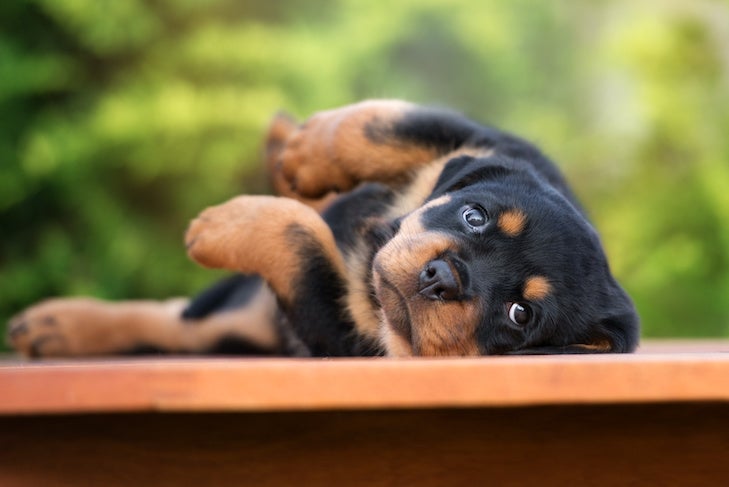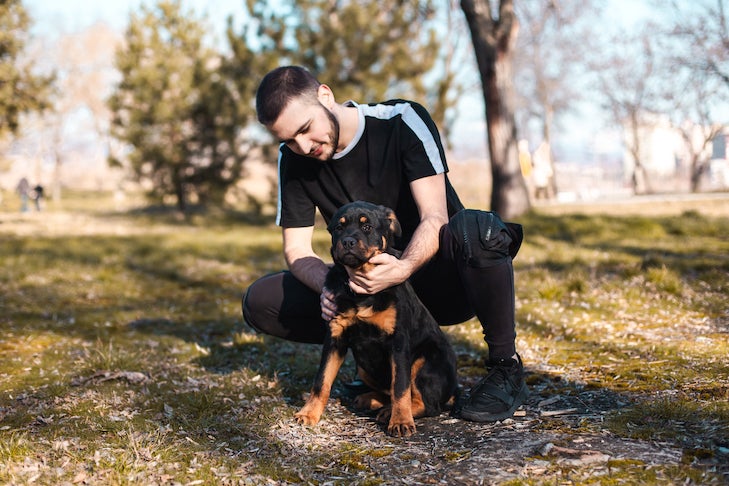
Rottweilers are a highly intelligent breed and are generally ready to please and eager to be trained. Teaching them good behavior and socializing them early on will help bring out the best in your puppy.
Teresa Bradley has been showing champion Rottweilers since 1987 and has been a breeder of Rottweiler champions since 1999. We talked to her for expert advice about the key training milestones for a Rottweiler puppy and how to best prepare for them.
Key Milestones: 6–7 Weeks
Rottweiler training begins before your puppy even comes home. Here’s what your breeder should be doing to help get your pet off to a good start.
Training Goal #1: Early Socialization While Still with the Breeder
“The first seven or eight weeks the puppy spends with the breeder are super important and this is why you want to find a breeder who spends time with the puppies in their home,” says Bradley. ” The puppies should be handled daily starting at birth.” They should also encourage visitors around the sixth or seventh week, especially children who giggle and make loud noises.
“The breeder needs to be careful to screen the visitors well so as to not bring in viruses like Parvo, but it’s also important that the puppies begin meeting strangers,” she adds. “Socializing with their littermates is also very important, especially in the sixth week. A puppy should never be taken from its litter prior to seven weeks for this reason.”
Key Milestones: 8–9 Weeks
Get ready for a lot of firsts, starting off right when you bring your Rottie home.
Training Goal #2: Set Your Expectations and Training Goals
What do you want your dog to be able to do by age one? Now is the time to think about these goals and lay the foundation for training right from the start.
For the average owner, Bradley says, typical goals may include learning basic manners, such as lying down and not begging during dinner, being able to heel when visitors come over, and coming when called—without getting distracted.
Training Goal #3: Keep Socializing Your Puppy with Strangers
Continuing the work your breeder should have started, it’s important to introduce your puppy to new people and surroundings, keeping in mind to avoid exposure to viruses, such as Parvo, which Rottweilers are “very susceptible to” explains Bradley.
Visit friends, have family over, or go to a large store where pets are allowed, so your dog can take in new sights, smells, and sounds.

Training Goal #4: Get Your Rottweiler Used to Nail Care and Other Grooming
While Rottweilers are generally a stress-free breed, when it comes to grooming, there are a few things you can begin doing right from the start, and that includes getting your dog used to nail care.
“Building a foundation for doing toenails is super important in this breed because they become strong and big so quickly and can be strong-willed,” Bradley says.
Breeders should begin getting Rottweiler puppies used to nail care starting at week one and continue with maintenance on a weekly basis.
Once you bring your pet home, be prepared to use a Dremel twice a week for the first two months of your puppy’s life and then once a week once you’ve established the habit. Try giving your Rottie a treat, like a bite of cheese, as a reward.
Baths don’t need to be given often (about once a month) and brushing can be done on a daily or weekly basis, as needed.
Training Goal #5: Introduce Basic Commands
At this age, Rotties “are sponges” says Bradley, “and can learn lots of things.”
Be prepared for a short attention span, however, and keep your teaching sessions to about five minutes. Start with teaching:
- Sit
- Down
- Stand
- Off
- Roll over
- Speak
- Shake a paw
“If you are sitting on the couch and your puppy jumps up, say ‘Off’ and then immediately [offer a] treat when they have four [feet] on the floor,” she explains. “If they stay off, feed them. If they jump back on, repeat the command—if you have to show them what you mean, gently push them off, then immediately feed a treat. They will learn ‘off’ very quickly.”
This same phrase can be used when your dog encounters new people and has the instinct to jump up on them.

Training Goal #6: Get Into Potty Training
Starting at five to eight weeks, Rottweiler puppies should have a designated area that is reserved for going to the bathroom.
“If they learn to just go on blankets or towels, or the floor, it will make the initial housebreaking a bit harder for the new owner,” explains Bradley.
Your job is to make sure your puppy has plenty of opportunities to go outside on a regular basis, so your dog can learn to find relief in the appropriate place.
Starting at eight weeks, your dog should be able to sleep overnight in a crate for five to six hours.
Training Goal #7: Try Leash Walking
“There is no specific age to do this,” says Bradley, adding that eight weeks is a good time to start. “Make sure they are comfortable wearing a collar before starting leash training. Once they stop scratching and being irritated by the collar, you can snap a leash on and follow them around.”
Once your dog gets comfortable with you following their lead, it’s time to try the other way around.
“You want to encourage them to follow you,” she adds. “Most puppies want to follow you, so encourage them to go with you only using light pressure if they stop, and lots of encouragement and praise.”
Training Goal #8: Explore Activities that Rottweilers Excel At
“Rottweiler puppies are extremely smart and can start learning anything as early as eight weeks if they are physically capable,” says Bradley.
She suggests trying out small agility obstacles, such as tunnels or a dog walk, as well as herding ducks, swimming, tracking, obedience work, scent work, and barn hunt foundational skills.
Because your puppy is still growing and the growth plates are still open, it’s important to avoid jumping and heavy exercise, like hikes.
Training Goal #9: Address Biting, Nipping, Growling, Guarding, and Other Unwanted Behaviors
“The Rottweiler has herding instincts and often likes to bite pant legs or chase,” says Bradley. These behaviors need to be discouraged, but since they’re natural, you don’t need to make a big deal out of them, she adds.
For the most part, you may be able to ignore the behavior or gently take your dog’s mouth away from a particular off-limits object.
With guarding behavior, she suggests taking the item away, using the word “out” and then giving the item back.
Be consistent with correcting these issues and dealing with them early on, and your puppy likely won’t be doing them anymore after four months. If you ignore them, however, they could become lifelong problems.

Key Milestones: 4 Months
It’s time for socializing with other dogs, and more.
Training Goal #10: Complete Your Puppy Shots and Socialize Your Rottweiler with Other Dogs
Once your dog is fully vaccinated, you can introduce your Rottweiler to other pets.
“When meeting other dogs, the owner should always supervise and make sure there is no bullying but appropriate dog-to-dog behavior,” says Bradley.
Training Goal #11: Enroll Your Dog in Obedience Classes
Because Rottweiler puppies should be fully vaccinated being exposed to other puppies, it’s best to wait to sign up for obedience classes until your dog is 16 weeks.
If you want to get started on expert training earlier, you can always “hire a private trainer, get advice from your breeder, sign up for a virtual class, or use another safe option,” says Bradley.
Don’t miss crucial information when it comes to raising your puppy. Get personalized training, nutritional, veterinary, and everyday advice sent straight to your inbox. Subscribe to Pupdate, a weekly email newsletter with customized content based on your puppy’s breed and age.

